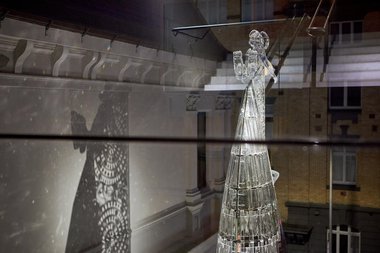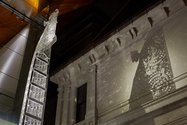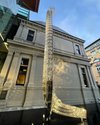John Hurrell – 19 July, 2021
With Paterson referencing a ‘ghost waka' apparently seen by tourist guide Sophia on Lake Tarawera ten days before the Tarawera eruption of 1886, this ornate and intricately constructed craft revels in elongated cast shadows on the high gallery walls—with arabesques, scrolls and distant navigation-aiding constellations—and at the waka ends the cast tauihu (crouching figure on the tip of the prow) and taurapa (ornate tail on the sternpost); triumphs of transparency and sparkling reflection.
Auckland
Reuben Paterson
Guide Kaiārahi
9 July 2021 - 9 July 2026
Parallel with the towering glass sides of the city’s art museum, and directed towards the sky, Reuben Paterson‘s thrilling ten-metre-high crystal and acrylic waka shimmers outside the entrance—its vertical supporting polished stainless steel armature hidden in the forecourt pool—a glittering pencil-shaped cloud of reflected white light for all visiting gallery attendees to admire.
Conceived, planned, designed and overseen by Paterson (Ngāti Rangitihi, Ngāi Tūhoe and Tūhourangi), production of the different complex elements and assembling the towering spaceship-like sculpture was executed by UAP (Urban Art Projects), the same Brisbane firm that built the Ronnie van Hout sculpture Boy Walking seen in Auckland’s Potters Park.
With Paterson referencing a ‘ghost waka‘ apparently seen by tourist guide Sophia on Lake Tarawera ten days before the Tarawera eruption of 1886, this ornate and intricately constructed craft revels in elongated cast shadows on the high gallery walls—with arabesques, scrolls and distant navigation-aiding constellations—and at the waka ends the cast tauihu (leaning figure on the tip of the prow) and taurapa (ornate tail on the sternpost); triumphs of transparency and sparkling reflection.
Surrounded by high-rise buildings the sculpture doesn’t get that much prolonged direct sunlight—only a few short hours during mid-afternoon—but there is light reflected onto it from nearby glass windows. Although it is the outside of the bow which is very visible through the gallery windows via the different levels of the mezzanine and gallery staircase landings, oddly it’s more fun to look into the curved shell of the boat’s hull (with its densely gridded floor of 595 vertically elongated, iridescent, chandelier crystals attached to 29 ribs) from the front. Especially at night when variations in spatial depth optically diminish and the dramatic tonal contrasts between the flat computer-cut acrylic sheets, stacked rows of faceted vertical rectangles, and carved rotund crystal forms effortlessly accentuate, partially because of the way spotlights are cleverly deployed.
Eleven waka seats (for oarsmen) become flat mirrored horizontal ‘boards’ that ascend heavenward like dark rungs in a kind of vertical Jacob’s Ladder. The spot-lit boat has a graphic flatness as it glows in stunning contrasts of black and white; no greys. It loses its substance and becomes like a huge magnificent borderless photograph.
Funded by the Edmiston Trust, this sensual public monument is a glorious contribution to the city’s art resources, and a spectacular (and unusually chromatically restricted) career showcase for the artist.
John Hurrell








 Advertising in this column
Advertising in this column Two Rooms presents a program of residencies and projects
Two Rooms presents a program of residencies and projects



This Discussion has 0 comments.
Comment
Participate
Register to Participate.
Sign in
Sign in to an existing account.